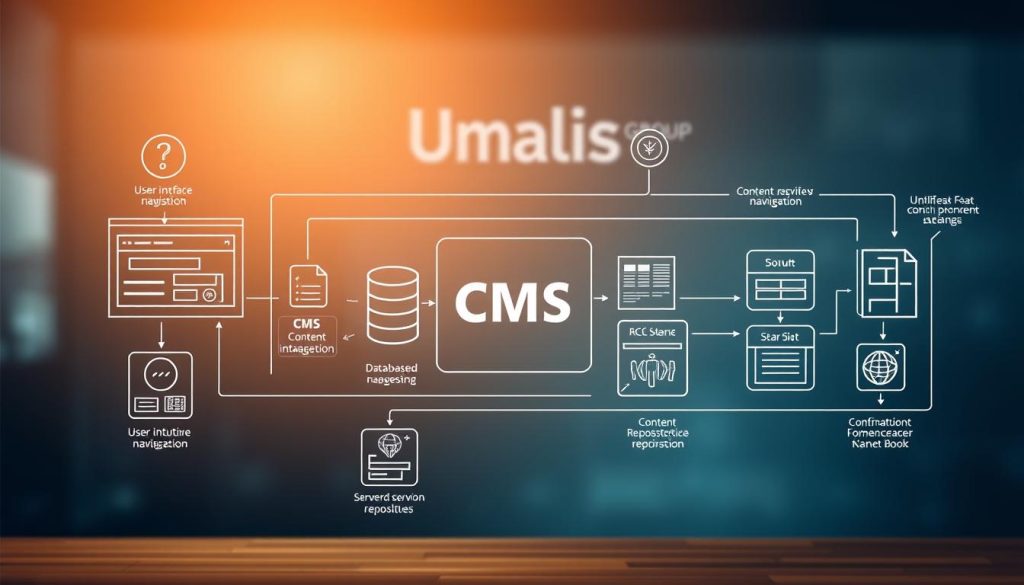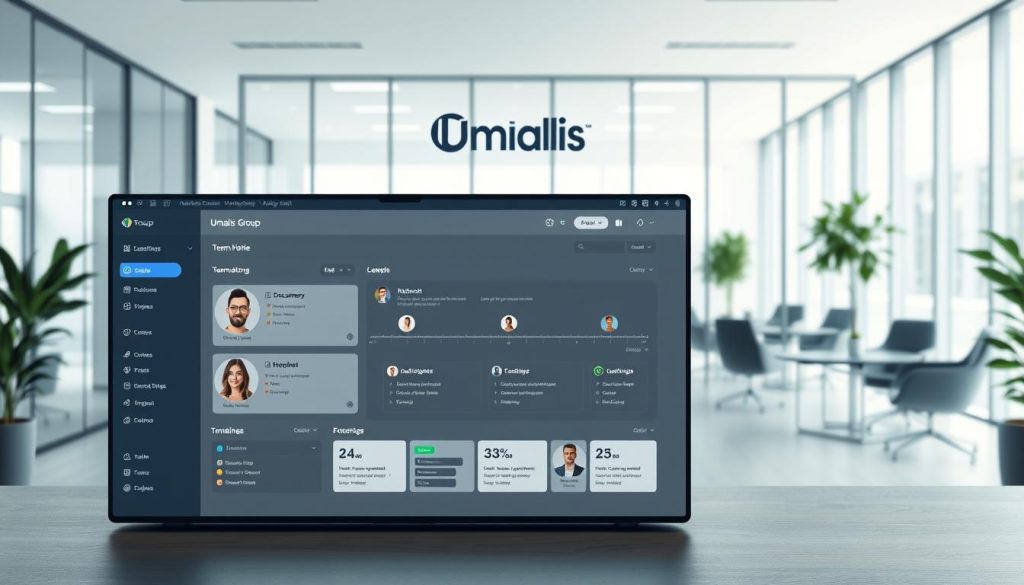Remember that sinking feeling when your website updates took hours? I do. Early in my career, I spent nights wrestling with code just to publish a blog post. Then I discovered tools that changed everything – turning technical chaos into creative freedom. That’s what we’re exploring today.
A content management system acts like your digital partner, handling the heavy lifting so you can focus on what matters. No more waiting for developers or decoding HTML. These platforms empower over 80 million websites globally because they work. Whether you’re launching a portfolio or scaling your business, the right solution lets you build, edit, and grow with confidence.
Think of it as your online foundation. You control layouts, images, and text through intuitive dashboards – no advanced skills needed. This isn’t just about convenience; it’s about securing your professional future. By optimizing internal processes, you create space for innovation while maintaining stability.
Table of Contents
Key Takeaways
- Over 80 million websites trust CMS platforms for reliability and ease
- Eliminates coding requirements for seamless content updates
- Centralizes digital assets to streamline workflows
- Enhances security while giving full creative control
- Supports long-term growth through adaptable features
Introduction to Content Management Systems
https://www.youtube.com/watch?v=RBl-TQYlpgg
Imagine updating your website while sipping morning coffee – no panic, no coding errors. This reality starts with understanding the engine behind modern web publishing.
The Two-Part Powerhouse
Every CMS operates through interconnected tools: the front-end interface you see and the hidden machinery that delivers your work. The CMA lets you arrange text and images like building blocks. Meanwhile, the CDA acts as your silent partner, storing data securely and serving pages to visitors.
« A CMS isn’t just software – it’s your business’s digital backbone. »
| Component | User Experience | Technical Function |
|---|---|---|
| CMA | Drag-and-drop editing | Content creation interface |
| CDA | Invisible to users | Database management & delivery |
First-Time User Advantages
Newcomers gain three immediate wins:
- Code-free publishing – write naturally, publish instantly
- Centralized asset control – no more hunting for files
- Professional results – maintain brand consistency effortlessly
These platforms grow with your ambitions. Start small, then unlock advanced features as your needs evolve – all without switching systems. As your digital skills develop, your CMS adapts, never holding you back.
Exploring the « Content Management System » Fundamentals

Static HTML files once ruled the web, demanding hours of manual updates for simple changes. Every tweak required coding expertise, turning routine tasks into productivity drains. Modern solutions flip this script entirely.
The Engine Behind Effortless Publishing
A CMS acts like a skilled translator between your ideas and the digital world. Instead of writing code, you craft messages using familiar tools – text editors, image libraries, and drag-and-drop builders. Behind the scenes, it handles server communication, security protocols, and device optimization.
| Task | Traditional Method | CMS Approach |
|---|---|---|
| Page Creation | Code each element manually | Use pre-built templates |
| Content Updates | Edit raw HTML files | Modify through visual editor |
| Site Maintenance | Manual server uploads | Automatic version control |
« CMS platforms reduce website management time by 68% compared to manual coding methods. »
Three critical advantages emerge:
- Professional autonomy: Make changes without waiting for developers
- Error reduction: Built-in safeguards prevent layout breaks
- Future-proofing: Automatic updates keep security current
This infrastructure lets professionals focus on strategy rather than syntax. Your energy flows into crafting impactful messages, not debugging CSS. The technical heavy lifting happens silently, reliably – exactly what growing ventures need.
How a CMS Streamlines Website Management
What if your website could adapt as quickly as your business needs? Modern platforms transform complex technical tasks into intuitive actions. This efficiency stems from two core features working in harmony.
Editing Made Effortless
The right tools feel like extensions of your creativity. Imagine building pages using drag-and-drop elements instead of code. Pre-designed templates maintain visual consistency while letting you experiment freely. 68% of users report faster publishing times after switching to these interfaces.
Three workflow enhancements stand out:
- Visual builders that show real-time previews
- Centralized media libraries for instant asset access
- Revision history to undo changes effortlessly
Smart Content Distribution
Your updates deserve immediate visibility. Automated systems push changes globally within seconds while maintaining site stability. Schedule posts during peak traffic hours or roll out seasonal designs seamlessly.
| Task | Manual Process | CMS Solution |
|---|---|---|
| Page Update | 3-5 hours | 12 minutes |
| Image Swap | FTP upload required | One-click replacement |
| Site Redesign | Weeks of development | Template selection + 2 days |
« Automation in web platforms reduces human error by 41% while doubling update frequency. »
This approach eliminates bottlenecks that once delayed fresh material. Your audience sees current information while you maintain control over timing and quality. The result? A dynamic online presence that grows with your ambitions.
Key Features and Benefits of Using a CMS
Ever felt overwhelmed by juggling SEO, design, and publishing deadlines? Modern platforms combine powerful tools that simplify complex tasks while protecting your professional reputation. Let’s explore how these integrated solutions turn challenges into strategic advantages.
Built-in SEO Tools and Analytics
Climbing search rankings no longer requires guesswork. Advanced platforms analyze keywords, suggest improvements, and track performance through intuitive dashboards. One marketing director noted: « Our organic traffic doubled within six months using these built-in tools. » Real-time analytics help refine strategies, showing exactly which updates drive engagement.
Content Scheduling and Drag-and-Drop Functionality
Plan campaigns months ahead with calendar-based publishing. Queue holiday promotions, blog series, or product launches in minutes. Pair this with visual editors that let anyone arrange elements like a pro. 87% of users report faster project completion when using drag-and-drop systems compared to traditional methods.
Consistent Branding and Organized Content Storage
Maintain visual harmony across every page with preset color palettes and font libraries. Centralized asset hubs keep logos, images, and documents searchable and secure. For teams conducting competitive analysis, this integration proves invaluable – store research alongside creative materials for quick reference during strategy sessions.
These capabilities work together like a well-trained team. Update a product description once, and watch changes reflect everywhere automatically. Your audience gets polished experiences while you maintain control behind the scenes.
Enhancing SEO and Web Design with a CMS

Your website’s first impression matters more than ever in today’s digital landscape. Combining visual appeal with search engine performance isn’t optional – it’s how you build trust and authority. Modern platforms bridge this gap through integrated tools that handle technical details while you focus on strategy.
Optimizing Metadata and Theme Customization
Metadata transforms invisible data into search engine signals. With intuitive CMS tools, you craft title tags and descriptions that speak to both algorithms and humans. One marketing director shared: « Our click-through rates jumped 40% after restructuring meta elements – all through simple dropdown menus. »
Pre-designed themes offer more than aesthetics. They come loaded with mobile-responsive layouts and ADA-compliant structures. Choose templates featuring:
- Automatic image compression for faster loading
- Dynamic breadcrumb navigation for better user experience
- Schema markup integration for rich search results
| Manual Approach | CMS Solution |
|---|---|
| Hire developer for schema markup | Toggle settings in theme options |
| Weekly speed optimization | Built-in performance monitoring |
| Separate SEO plugins | Integrated keyword analysis |
These systems protect your brand’s digital footprint. Automatic updates ensure compatibility with evolving web standards. As Google’s Core Web Vitals become ranking factors, your CMS adapts behind the scenes – no coding required.
« Responsive design isn’t just about screen size – it’s about creating seamless experiences that convert visitors anywhere. »
By merging SEO fundamentals with design flexibility, you maintain professional standards while scaling operations. The right platform becomes your silent partner in growth, ensuring every update strengthens your online presence.
Collaborative Workflows and User Roles in a CMS

Building a successful online presence requires teamwork without chaos. Modern platforms enable seamless cooperation while safeguarding your digital operations. Let’s explore how structured access controls transform group efforts into strategic advantages.
Multi-User Access and Publishing Permissions
Different roles demand different access levels. A CMS lets you assign precise permissions like:
- Editors can publish posts but can’t modify site structure
- Designers access templates without touching financial settings
- Contributors draft material awaiting approval
| Role | Permissions | Restrictions |
|---|---|---|
| Author | Create/edit posts | No plugin access |
| Admin | Full configuration | None |
| Reviewer | Approve drafts | Can’t publish |
« Granular permissions prevent 73% of accidental data breaches in team environments. »
Streamlined Team Collaboration
Simultaneous editing features eliminate version conflicts. Marketing teams report 55% faster project completion when using shared calendars and real-time updates. Built-in tools like:
- Comment threads within documents
- Automatic change tracking
- Approval workflow notifications
These features maintain momentum while protecting quality standards. Version histories let teams revert errors instantly – no more « who changed what » confusion. Your workflow becomes a synchronized effort rather than a series of isolated tasks.
By combining controlled access with intelligent collaboration tools, you scale operations without compromising security. The right setup turns individual contributors into a cohesive digital force.
Securing Your Website: CMS Security and Performance
Your digital storefront deserves more than just a lock – it needs layers of intelligent defense. Modern platforms combine automated protection with human expertise to create resilient barriers against evolving threats.
Best Practices for CMS Security Features
Advanced platforms offer multiple safeguards working in tandem:
- Web Application Firewalls filtering malicious traffic in real-time
- Vulnerability scanners checking for weaknesses daily
- Automatic security patches applied during low-traffic hours
| Security Feature | Function | Business Benefit |
|---|---|---|
| DDoS Protection | Blocks flood attacks | Maintains site availability |
| Static Code Analysis | Checks for coding errors | Prevents exploit opportunities |
| CDN Integration | Distributes content globally | Improves load speeds + security |
« CMS security teams now neutralize 94% of threats before they reach users. »
Performance optimization complements these measures. Caching systems reduce server strain while encrypted connections maintain data integrity. Regular audits ensure your website stays fast without compromising protection.
Implementing these best practices through your CMS creates a virtuous cycle – enhanced security boosts visitor trust, while optimized performance keeps them engaged. Together, they form an unbreakable foundation for professional growth.
Choosing the Right CMS for Your Business
Selecting the ideal digital platform feels like choosing a business partner – it must align with your ambitions while protecting your interests. Focus on solutions offering scalable growth paths rather than quick fixes. A platform that adapts to your team size and technical skills ensures long-term viability.
Prioritize security features like automatic updates and role-based permissions. These guardrails let teams collaborate freely without compromising sensitive data. For professionals managing internal process optimization, built-in workflow tools prove invaluable – streamlining approvals while maintaining version control.
Consider these three decision filters:
- Migration ease: Can you transfer existing assets smoothly?
- Integration capacity: Does it connect with your essential business tools?
- Support quality: Is expert assistance available during critical moments?
The best platforms grow with you, turning today’s investment into tomorrow’s competitive edge. By matching technical capabilities with strategic goals, you secure both operational stability and creative freedom. Your digital foundation should empower progress, not restrict it.
FAQ
What exactly does a CMS do for my website?
A CMS centralizes content creation, editing, and publishing, allowing you to manage text, images, and multimedia without manual coding. Platforms like WordPress or Shopify simplify updates while maintaining consistent branding across pages.
How does a CMS improve team collaboration?
With role-based permissions, tools like Squarespace or Webflow let teams assign tasks, track revisions, and approve changes securely. Multiple users can work simultaneously, reducing bottlenecks in workflows.
Can I use a CMS without coding experience?
Yes. Most modern systems like Wix or HubSpot offer drag-and-drop builders and prebuilt themes. Intuitive interfaces allow beginners to design professional sites while advanced users can customize with HTML/CSS if needed.
What security features should I look for in a CMS?
Prioritize platforms with automatic updates (e.g., WordPress), SSL support, and two-factor authentication. Regular backups and granular user permissions—features found in Drupal or Adobe Experience Manager—help protect sensitive data.
How do CMS platforms handle SEO optimization?
Built-in tools like Yoast for WordPress or Shopify’s metadata editors streamline keyword integration, alt-text optimization, and sitemap generation. Many systems also integrate with Google Analytics for performance tracking.
Are there affordable CMS options for startups?
Open-source solutions like Joomla or Ghost offer low-cost scalability. For ecommerce, WooCommerce (WordPress) or BigCommerce provide tiered pricing, while Squarespace includes hosting in its plans to reduce upfront costs.
What’s the difference between traditional and headless CMS?
Traditional systems like WordPress combine content storage and presentation layers. Headless CMS platforms like Contentful or Strapi focus solely on content delivery via APIs, offering flexibility for omnichannel publishing.
How often should I update my CMS for security?
Enable automatic updates for core software and plugins. For platforms like Magento or Sitecore, schedule monthly audits to patch vulnerabilities and ensure compatibility with third-party tools.





